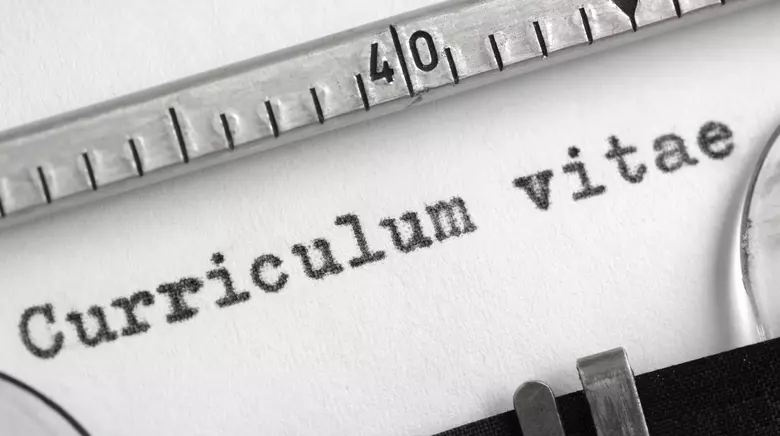Application Documents: The First Impression Counts

Open table of content
Close table of content
- Read the Job Announcement Carefully & Evaluate the Company
- Putting Together Your Application
- The Cover Letter for Your Application
- The Resume in Tabular Form
- Publications and Project References
- Certificates, Employment References, Testimonials
- Short Applications and Competency Profiles
- A Certificate of Good Conduct
A carefully-prepared application package is a lot of work and takes time. It's better therefore to plan a whole day rather than just a few hours to put it together.
Found a job ad? Now pay attention to the desired application method in the job advertisement (by post, email, eform, etc.) as well as the completeness of your documents. If nothing is mentioned to the contrary in the job advertisement, a complete application should include the following documents:
- Cover letter
- Resume in tabular form
- Employment references
- Proof of education and training
As a general rule, there is no set standard for application documents. You are free to design and structure them as you wish. However, some things have proven successful and are regarded as appealing. We have put together some tips for you. Read them for yourself!
Read the Job Announcement Carefully & Evaluate the Company
In order to put together a compelling application, you must first and foremost really want the job. Check whether the professional requirements match your experience and skills. You should also apply however, even if there is something you do not yet possess. In this case, emphasize in your cover letter your willingness or your concrete plans for further training. If a recruiter can clearly recognize your readiness or motivation for further training, a lack of skills is usually not a criterion for rejection.
OUR TIP
Let the employer know that you are willing to make your own inquiries about training opportunities and funding. Alternatively, we can assist your future boss with finding current funding opportunities in Berlin. Contact us at talent@berlin-partner.de!
Equally important are your personal requirements for a job. Take a closer look at the job advertisement and the job in question and see what your potential employer can offer YOU! Is there any mention of “flat hierarchies” or are there clearly-defined company structures? Does it address work-life balance, a family-friendly environment, diversity, sustainability, home office and ongoing professional development?
Get an idea in advance how these values are embodied within that particular company! You can usually find information about these aspects on the company's own website. Basically: Be creative in order to get deeper insight into the company.
For example, go to events organized by the company or browse ahead of time through various websites looking for company reviews. Often companies also provide good insight into their own everyday work on social media, especially in business networks such as LinkedIn and Xing. Get a clear picture in advance and only apply if the job would be a good fit for you and if you would be a good fit for the job.
Reviews of companies in Berlin
Putting Together Your Application
Select a standard readable font, a maximum of two font sizes and only one font color. If you want to emphasize something, choose a bold font or underline a word or phrase. Doing both would be too much. Make sure your document has sufficient margins at the top, bottom, left and right – 2.5 cm is the norm in this regard.
If nothing else is required, merge all parts of the application into one PDF document and label the file. The file name should consist of your name, the abbreviation of the job title and, if available, the job number. The file should not exceed 5 MB. In exceptional cases, 10 MB is allowed, though rarely more than that.
Remember that your documents will be printed out and passed around the company. Therefore, number your document with page numbers. If you like, you can also insert your name in small letters next to the page numbers. All this is not a must or a norm, but it makes the recruiters’ work easier.
OUR TIP
In any case, have your application proofread by someone who has the confidence to tell you if they do not understand or do not like something. Any mistakes that they find will not be found again by the recruiters.

Cover Sheet and Photo
A cover sheet is a matter of personal taste, tactfulness, and your personality. Consider what added value and benefit such a sheet could have for the company you have chosen. In the worst case, it is only one more page that a recruiter has to read. Some recruiters find that two pages of resume are enough. Decide on an individual basis foreach application.
If you decide to do one, use the cover sheet to add a personal touch and highlight your profile with your contact details and the skills that are most relevant for the job. Ask yourself what you can add to convince the recruiter within a few seconds.
Whether on the cover sheet or on the resume – a photo is not obligatory, but it does make a positive impression on job applications. Decide for yourself whether you want to include a photo.
OUR TIP
By the way, the same applies to your age, background information about children and marital status. You decide what goes into the application.
The Cover Letter for Your Application
A cover letter should be no longer than one A4 page and should be divided into a maximum of three to four paragraphs. In the subject line, please note the job title and the number assigned (if there is one) to the vacancy. In some companies, cover letters are read very carefully, in others they are not. You have a 50/50 chance. Take full advantage of it.
The Introduction: Short and to the Point
Choose a brief and direct introduction to your cover letter. What are you looking for and why? Or what is your current situation? For example: “I will finish my studies in July. That’s why I’m looking for an entry-level position as a ... starting in August”.
Continue to refer to the advertised position by making an initial connection to your experience. Do not repeat what you have already written in the subject line – namely, which position you are applying for.
OUR TIP
In general, avoid repeating your resume in tabular form. All your career stages are already clearly recognizable in it.
The main body: Make connections
Use the second paragraph of your cover letter to describe a special experience, a project or a detail that is not specifically mentioned in the resume but is related to the job, the company, or the products, or serves as proof that you have the desired expertise.
Avoid generic phrases like “I am a team player, able to work under pressure, and motivated.” Instead, describe exactly what you have done, what you are interested in or what you find challenging.
OUR TIP
Use phrases from the job advertisement and incorporate them skillfully. Highlight important keywords. When cross-reading, this will help the recruiter identify a match with the profile they are looking for.
The conclusion: Don’t forget anything
The last paragraph is devoted to the figures, data, and facts – depending on the information that is requested. When can you start? What are your salary expectations?
OUR TIP
Specify a salary range with a maximum of €5,000 leeway. On the internet, research the current collective agreements in the industry as a guide.
Maybe you can think of something other than “I would welcome an opportunity to discuss my qualifications with you.” Recruiters are always happy to read something different. Also, don´t forget to sign your letter or include your scanned signature.
The Resume in Tabular Form

It is common practice to submit a resume in tabular form. List the following information in your resume:
- Professional career
- Education and training
- Skills and expertise
- Contact details
In the case of the first two points, always start with your most recent position.
OUR TIP
If your work experience includes time spent abroad, simply list the country next to the year. In this way, you can show that you have experience abroad and don't have to mention this fact separately.
State where you worked, i.e., the name of the company, and what your role was or the job title. Describe in three to five lines at the most what exactly you did there or what you were responsible for.
Again, focus on the job you want and what is relevant and important to the company. Use verbs that describe, for instance, that you were responsible for an entire process from A to Z. Here is an example: research, analyze, evaluate, and prepare data for customer presentations.
OUR TIP
Are you a young professional? Then internships are important evidence. List them under your professional career. Here, too, it is important to describe what exactly you did and learned there.
Courage to Have Gaps in Your Resume
Gap-free resumes are a hotly-debated topic. The most important thing is that you can explain your gaps. For example, caring for relatives, a sabbatical year, and a longer period of professional reorientation are justifiable reasons for a gap. Details and motives for them may be asked by the recruiter during the interview. Be honest! If in doubt, simply do not include the gaps in your application. Company takeovers, restructuring, and staff reductions can affect anyone. Be proactive about it! Nowadays, gaps in a resume should no longer be a reason for rejection.
Languages, Computer Skills, Hobbies
Language skills and computer skills round out your resume. We are often asked, “Can I list hobbies or is it better not to?” The answer: There is no obligation.
If the hobby reveals a personal trait that bears an indirect or additional link to the desired job, then the information could be the icing on the cake for your application. For example, if you are a coach in a club or play a team sport more or less professionally, this conveys interesting evidence of qualities that are often required, such as the ability to work in a team, resilience, and determination. Reading, hiking, and swimming, on the other hand, are more general hobbies and not quite as revealing.
OUR TIP
Photography, facilitating, writing books and giving lectures – all hobbies at a professional level – are best included in the “Other Professional Activities” section.
To verify language skills, the most important or highest-level certificate is sufficient.

Publications and Project References
Publications and project references should be listed on a separate page on your resume. Scientists and authors keep a list of publications; musicians a list of their compositions and CDs; filmmakers compile their work as a filmography; and the creative industry maintains a list of projects. It all depends on what kind of work you are applying for.
For example, if you are applying as a graphic designer for an agency, your project list will be read by an insider. Your work samples will be the determining factor. If you are applying with the marketing department of an institute, association or company, however, this is often not enough. In those cases, it is not industry insiders who review your documents, but human resources staff. They are more likely to look at job references and proof of qualifications.
The same applies to lists of publications by academics. Always ask yourself: Can my addressee make sense of this? Is it critical for the job? This calls for a certain amount of tactfulness. The statement “a complete list can be submitted later upon request” leaves all options open.
Certificates, Employment References, Testimonials
With your application documents, enclose the most recent and important final certificates from your studies and vocational training as well as advanced training certificates. The more recent your career starts, the more complete the documents should be. As a young professional, you should also enclose proof of internships. Later, these can be omitted. If you are further along in your career, the references from your previous employers count.
In Germany, employment references are very important. They are more or less considered a testimonial. As an employee, you are entitled to an employment reference. It should describe your duties and responsibilities, and assess your performance.
You can also list people who can confirm certain professional qualifications or testify to joint professional projects. Of course, these people should then be aware that they might be contacted.
OUR TIP
If you name people as references, then also specify the topic, skill or project on which they can provide information.
Work Samples
There is a high demand for work samples, especially in the creative professions. In the IT field, a simple code can be submitted. Alternatively, a technical article you have published on the topic or a link to a video of you delivering a technical lecture might also be suitable for this purpose.
Short Applications and Competency Profiles
If you receive a tip from your network about a vacancy and even a name with an email address to which you can send your documents, then the following applies: Be brief! Don´t immediately present your complete resume in the first email.
OUR TIP
Come up with a few concise sentences. What is important is that you state who you are, what your profession is. and what kind of job you are looking for with this company. Get straight to the point and say briefly what you want (specifically, to send in an application) and ask who your contact person would be for this. This also applies to a phone call or online chat.
Short competency profiles, also called short resumes, are a good approach for unsolicited applications. A competency profile consists of a single page with your name and profile details. A photo is not required. Create a synopsis of your resume up to now. This enables you to provide the company with a brief overview of relevant professional and leadership competences.
A Certificate of Good Conduct
A certificate of good conduct is a document printed on special paper that provides information on whether a person has a previous criminal record or not, and includes full personal details. The document costs €13 and must be applied for at the Citizens’ Registration Office (Bürgeramt) in your local district of residence. It usually takes one to two weeks to process. It is best to find out in advance whether you need a certificate of good conduct for your dream job. Apply for a certificate of good conduct online from one of Berlin´s Citizens Registration Offices.


